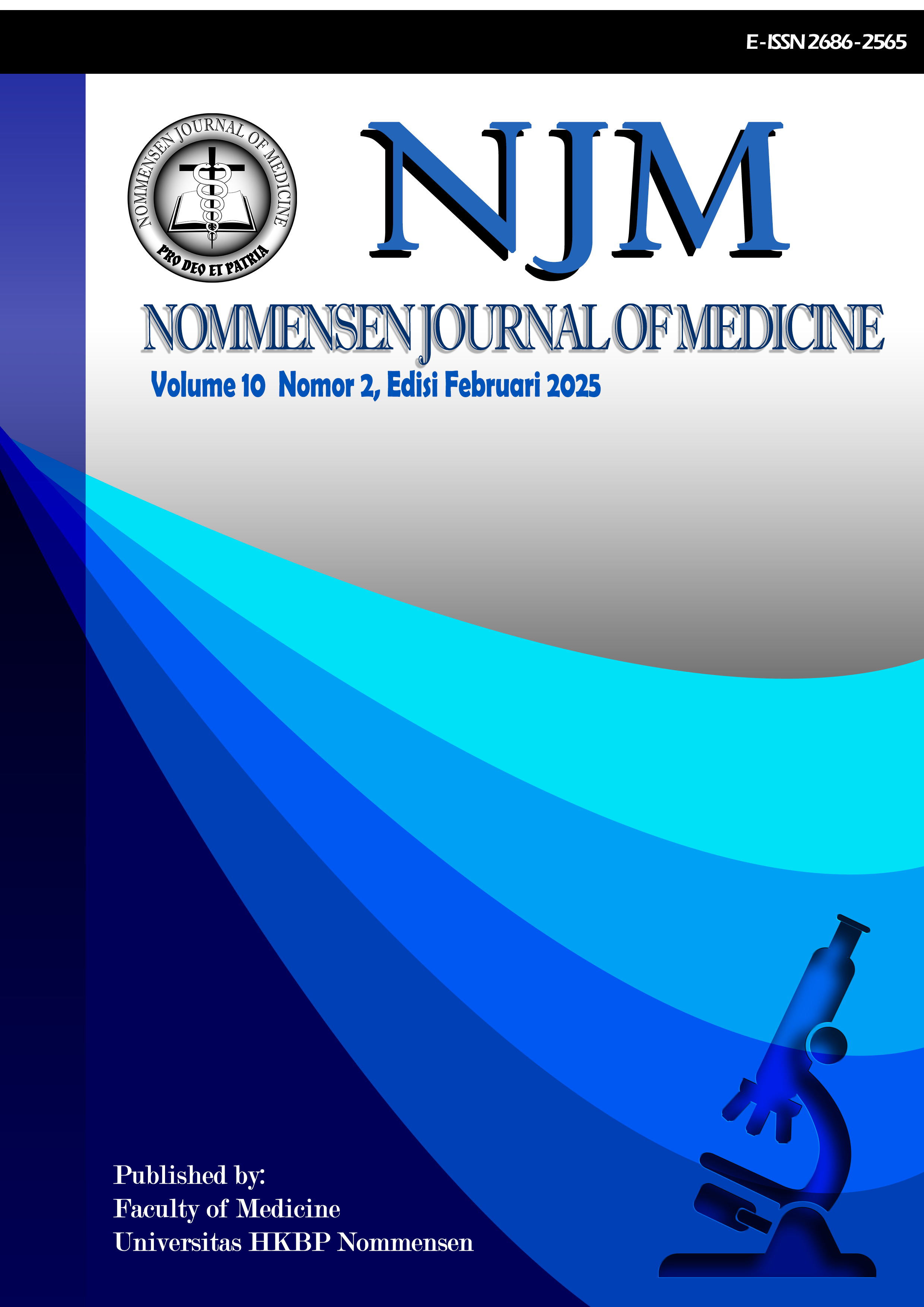Gambaran Tingkat Pengetahuan, Sikap, dan Prilaku Pencegahan Penyakit Pedikulosis Kapitis pada Anak-Anak di Panti Asuhan Hasami Kasih Tahun 2024
Abstract
Background: Pediculosis capitis is a common head lice infestation among children, particularly in environments with suboptimal hygiene, such as orphanages. A lack of knowledge, attitudes, and preventive behaviors can increase the risk of disease transmission.
Objective: To determine the level of knowledge, attitudes, and preventive behaviors regarding pediculosis capitis among children at Hasami Kasih Orphanage, Medan, in 2024.
Methods: This study employs a descriptive method with a cross-sectional approach. A total of 15 children who met the inclusion and exclusion criteria were selected using purposive sampling. Data were collected through questionnaires and analyzed descriptively using computer software.
Results: The findings show that most respondents were aged 9–13 years (66.7%) and were male (73.3%). The prevalence of pediculosis capitis was 26.6%, occurring exclusively in female respondents. The majority of respondents had good knowledge (66.7%) and very positive attitudes (66.7%) toward prevention. However, preventive behavior was still in the moderate category (80%).
Conclusion: The children in this orphanage generally have good knowledge and attitudes regarding pediculosis capitis prevention. However, preventive behavior still needs improvement. Further research is needed to identify other factors influencing the occurrence of pediculosis capitis and to examine the relationship between knowledge, attitudes, and preventive behaviors in infestation cases.
References
2. Peterson, R.; A, Nash, E.;, Anderson, J. B. Infectious Disease in Contact Sports. Sports Health. 2019;11(1):47–58.
3. A V, D R. Biologi dan genetika kutu kepala dan tubuh manusia. Tren Parasitol. 2024;28:563–71.
4. RiswandaJ., Arisandi Y. Pediculosis capitis. 1st ed. Arisandi Y, editor. palembang: scribe; 2022. 86–100 p.
5. Monalisa AC. Gambaran Kejadian Pedikulosis Kapitis pada Siswa-Siswi Sekolah Dasar Negeri di Kecamatan Medan Selayang. 2018;
6. Hadidjaja, P., Margono SS (Eds. . Dasar Parasitologi Klinik. Fakultas Kedokteran Universitas Indonesia; 2014. 372 p.
7. Leung, C. AK, Lam, J. M. L, F. K, Barankin, et al. Paediatrics: how to manage pediculosis capitis. 2022.
8. Prof. Dr. R.S. Siregar SK. Atlas Berwarna Saripati Penyakit Kulit Edisi 2. 2nd ed. jakarta; 2014. 168–169 p.
9. Nurlatifah I, Astuti RDI, Indrasari ER. Seminar Penelitian Sivitas Akademika Unisba, Prosiding Pendidikan Dokter Gelombang 2 volume 3. Fakultas Kedokteran Unisba; 2017. 575 p.
10. RP H. Pedikulosis. S. Linuwih. Jakarta: Balai Penerbit FKUI; 2016.
11. Arisanti D, Widyanti T, Hasnah, Rustiah WO, Ernawati. Gambaran Pediculosis Pada Anak-anak Panti Asuhan di Kota Makassar. J Heal Sci Technol [Internet]. 2024;5. Available from: https://www.researchgate.net/publication/381298452_Gambaran_Pediculosis_ Pada_Anak-Anak_Panti_Asuhan_di_Kota_Makassar#full-text
12. Noersyamsidar, Suprihartini. Gambaran Infeksi Pediculus Humanus Capitis Terhadap Anak-Anak di UPTD Panti Sosial Perlindungan Anak Dharma. Borneo J Sci Math Educ [Internet]. 2022;2. Available from: https://repository.poltekkes-kaltim.ac.id/1776/1/document.pdf
13. Bengi RS. Hubungan tingkat pengetahuan sikap dan perilaku santri derajat keparahannya terhadap kejdian pedikulosis kapitis di Pondok Pesantren Subulussalam Kecamatan Plaju Palembang. 2019;14. Available from: https://repository.unsri.ac.id/23713/3/RAMA_11201_04011181621051_00020 18802_004108106_01_front_ref.pdf
14. Dagne H, Biya AA, Tirfie A, Walelegn Worku Yallew BD. Prevalence of pediculosis capitis and associated factors among schoolchildren in Woreta town, northwest Ethiopia. BMC Res Notes [Internet]. 2019;12:1–6. Available from: https://bmcresnotes.biomedcentral.com/counter/pdf/10.1186/s13104 019-4521-8.pdf
15. Fadhillah MF, Anwar C, Liberty IA. Risk factors for the event of pediculosis capitis in the Baturaja Orphanage, South Sumatera, Indonesia. Biosci Med J Biomed Transl Res [Internet]. 2021;9(5):871–8. Available from: https://bioscmed.com/index.php/bsm/article/view/354/415
16. Riswanda Jhon, Chairil A, Zulkarnain, Mohammad, Sitorus, Januar R. Analysis of socio-economic status, morphology, and dominant factors of personal hygiene behavior on the incidence of pediculosis capitis at Orphanages in Palembang City, Indonesia. Budapest Int Res Critics Inst [Internet]. 2022;5(2):9989–96. Available from: https://www.bircu-journal.com/index.php/birci/article/view/4795/pdf
17. IMS A, NW T, NPW O, SA M. Metodologi Penelitian Kesehatan. 2021.
18. Mahendra D, Jaya IMM, Lumban AMR. Buku Ajar Promosi Kesehatan. Progr Stud Diploma Tiga Keperawatan Fak Vokasi UKI. 2019;1–107.
19. Azhar SLY Al, Miharlina S, Arisanty R, Jelita H. Hubungan Antara Kebersihan Diri dan Jenis Kelamin dengan Kejadian Pedikulosis Kapitis pada Murid SD Tahun 2018. Fak Kedokt. 2020;
20. Marsel OA, Syamsuddin H. Hubungan Pengetahuan Tentang Penyakit Pedikulosis kapitis dan Perilaku Kebersihan Diri Dengan Kejadian Pedikulosis Kapitis pada Santriwati Angkatan 2017 Pondok Pesantren Modern Al-Mizan Pandelang Banten. 2017;
21. Rahmawati RK, Teresa A, Mutiasari D, Jelita H. Hubungan Tingkat Pengetahuan dan Perilaku Penggunaan Sampo Terhadap Kejadian Pedikulosis Kapitis di Panti Asuhan X Palangka Raya. Kedokteran. 2020;
22. Anggraini A, Anum Q, Masri M. Hubungan Tingkat Pengetahuan dan Personal Hygiene terhadap Kejadian Pedikulosis Kapitis pada Anak Asuh di Panti Asuhan Liga Dakwah Sumatera Barat. Kedokteran. 2018;
23. Mitriani, S., Rizona, F. & Ridwan M. Hubungan Pengetahuan dan Sikap tentang Pediculosis Capitis dengan Perilaku Pencegahan Pediculosis Capitis pada Santri Asrama Pondok Pesantren Darussalam Muara Bungo. Kedokteran. 2017;

This work is licensed under a Creative Commons Attribution-NonCommercial 4.0 International License.



